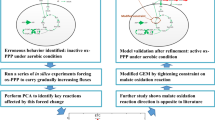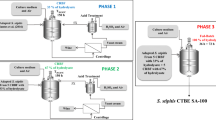Abstract
A detailed in silico analysis of different strategies for enhancement of bioethanol production by Scheffersomyces stipitis, = Pichia stipitis, using validated genome-scale metabolic model is presented. Glucose inhibition on xylose uptake is dominant in S. stipitis which makes fed-batch fermentation more effective for higher sugar concentrations. Bioethanol production potential of S. stipitis can be improved by growth media modification by introducing certain amino acids in small quantities. Slower sugar uptake by S. stipitis can be overcome by community-culture with recombinant Escherichia coli strain ZSC113, which has a higher xylose uptake rate. Ethanol yield and productivity of community-culture can be further enhanced by genetic modification of E. coli strain ZSC113.



Similar content being viewed by others
Abbreviations
- A :
-
Matrix of stoichiometric coefficients
- a :
-
Specific interfacial air–liquid area, m−1
- E :
-
Ethanol concentration g l−1
- e:
-
Ethanol
- EC:
-
Escherichia coli
- F :
-
Feed rate l h−1
- G :
-
Glucose concentration g l−1
- G f :
-
Glucose concentration in the feed g l−1
- g:
-
Glucose
- K :
-
Half-saturation constant for substrate uptake g l−1
- K ie :
-
Ethanol inhibition constant for substrate uptake g l−1
- K igz :
-
Glucose inhibition constant for xylose uptake g l−1
- k L :
-
O2 mass transfer coefficient m h−1
- O :
-
Dissolved O2 concentration g l−1
- o:
-
O2
- SS:
-
Scheffersomyces stipitis
- V :
-
Volume l
- v :
-
Vector of reaction and exchange fluxes
- w :
-
Vector of weights with contribution of flux to cell mass formation
- X :
-
Cell mass concentration g l−1
- Z :
-
Xylose concentration g l−1
- z:
-
Xylose
- Z f :
-
Xylose concentration in the feed g l−1
- µ :
-
Specific growth rate h−1
References
Agbogbo FK, Coward-Kelly G, Torry-Smith M et al (2006) Fermentation of glucose/xylose mixtures using Pichia stipitis. Proc Biochem 41:2333–2336
Balagurunathan B, Jonnalagadda S, Tan L et al (2012) Reconstruction and analysis of a genome-scale metabolic model for Scheffersomyces stipitis. Microb Cell Fact 11:27
Becker SA, Feist AM, Mo ML et al (2007) Quantitative prediction of cellular metabolism with constraint-based models: the COBRA toolbox. Nat Protoc 2:727–738
Feist AM, Henry CS, Reed JL et al (2007) A genome-scale metabolic reconstruction for Escherichia coli K-12 MG1655 that accounts for 1260 ORFs and thermodynamic information. Mol Syst Biol 3:121
Grootjen DRJ, van der Lans RGJM, Luyben KCAM (1991) Conversion of glucose/xylose mixtures by Pichia stipitis under O2-limited conditions. Enzyme Microb Technol 13:648–654
Gutierrez-Rivera B, Waliszewski-Kubiak K, Carvajal-Zarrabal O et al (2012) Conversion efficiency of glucose/xylose mixtures for ethanol production using Saccharomyces cerevisiae ITV01 and Pichia stipitis NRRL Y-7124. J Chem Technol Biotechnol 87:263–270
Hanly TJ, Henson MA (2013) Dynamic metabolic modeling of a microaerobic yeast co-culture: predicting and optimizing ethanol production from glucose/xylose mixtures. Biotechnol Biofuels 6:44
Hanly TJ, Urello M, Henson MA (2012) Dynamic flux balance modelling of S. cerevisiae and E. coli co-cultures for efficient consumption of glucose/xylose mixtures. Appl Microbiol Biotechnol 93:2529–2541
Kim J, Reed JL (2010) OptORF: optimal metabolic and regulatory perturbations for metabolic engineering of microbial strains. BMC Syst Biol 4:53
Lisha KP, Sarkar D (2014) Dynamic flux balance analysis of batch fermentation: effect of genetic manipulations on ethanol production. Bioprocess Biosyst Eng 37:617–627
Mahadevan R, Edwards JS, Doyle FJ (2002) Dynamic flux balance analysis of diauxic growth in Escherichia coli. Biophys J 83:1331–1340
Orth JD, Thiele I, Palsson BO (2010) What is flux balance analysis? Nat Biotechnol 28:245–248
Slininger PJ, Dien BS, Gorsich SW et al (2006) Nitrogen source and mineral optimization enhance D-xylose conversion to ethanol by the yeast Pichia stipitis NRRL Y-7124. Appl Microbiol Biotechnol 72:1285–1296
Taniguchi M, Tohma T, Itaya T et al (1997) Ethanol production from a mixture of glucose and xylose by co-culture of Pichia stipitis and a respiratory deficient mutant of Saccharomyces cerevisiae. J Ferment Bioeng 83:364–370
Unrean P, Nguyen NHA (2013) Optimized fed-batch fermentation of Scheffersomyces stipitis for efficient production of ethanol from hexoses and pentoses. Appl Biochem Biotechnol 169:1895–1909
Weierstall T, Hollenberg CP, Boles E (1999) Cloning and characterization of three genes (SUT13) encoding glucose transporters of the yeast Pichia stipitis. Mol Microbiol 31:871–883
Author information
Authors and Affiliations
Corresponding author
Electronic supplementary material
Below is the link to the electronic supplementary material.
Rights and permissions
About this article
Cite this article
Parambil, L.K., Sarkar, D. Probing the bioethanol production potential of Scheffersomyces (Pichia) stipitis using validated genome-scale model. Biotechnol Lett 36, 2443–2451 (2014). https://doi.org/10.1007/s10529-014-1629-8
Received:
Accepted:
Published:
Issue Date:
DOI: https://doi.org/10.1007/s10529-014-1629-8




